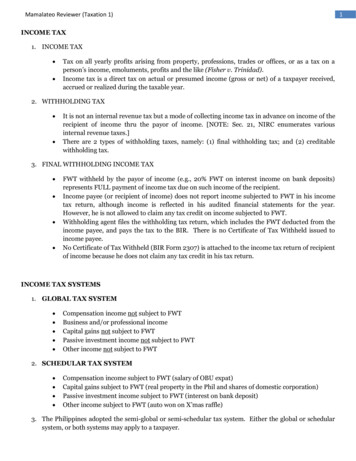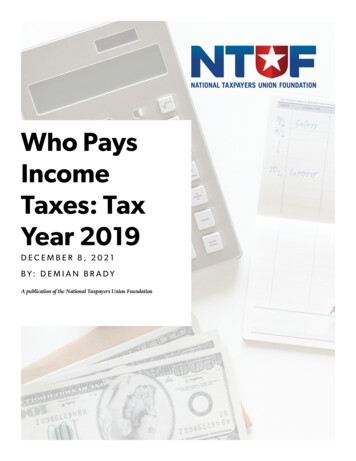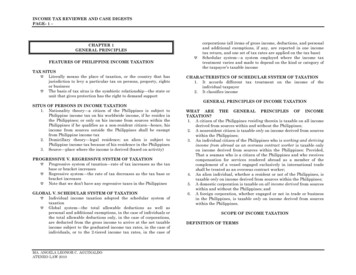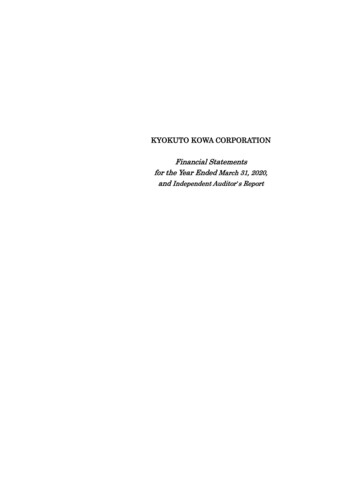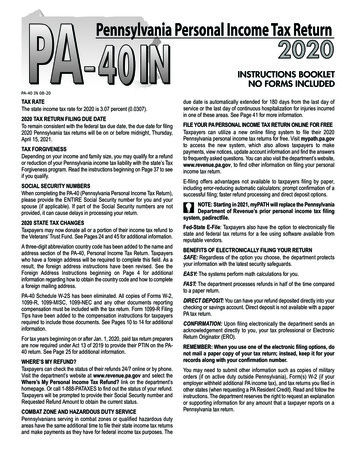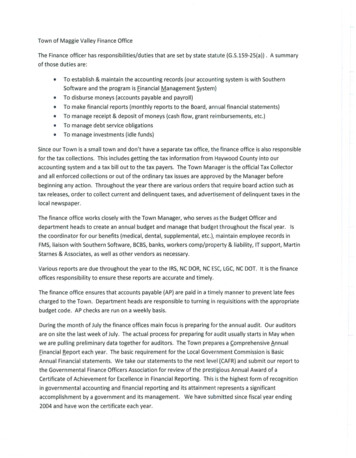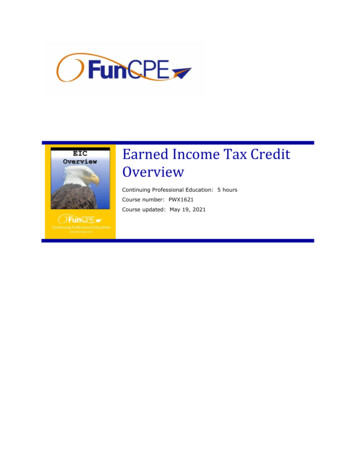
Transcription
Earned Income Tax CreditOverviewContinuing Professional Education: 5 hoursCourse number: PWX1621Course updated: May 19, 2021
Copyright 2014 - 2021 by Paul J. Winn CLU ChFCALL RIGHTS RESERVED. NO PART OF THIS COURSE MAY BE REPRODUCED IN ANY FORM OR BY ANYMEANS WITHOUT THE WRITTEN PERMISSION OF THE COPYRIGHT HOLDER.All materials relating to this course are copyrighted by Paul J. Winn CLU ChFC. Purchase of a courseincludes a license for one person to use the course materials. Absent specific written permission fromthe copyright holder, it is not permissible to distribute files containing course materials or printedversions of course materials to individuals who have not purchased the course. It is also notpermissible to make the course materials available to others over a computer network, Intranet,Internet, or any other storage, transmittal, or retrieval system. This document is designed to providegeneral information and is not a substitute for professional advice in specific situations. It is notintended to be, and should not be construed as, legal or accounting advice which should be providedonly by professional advisers.PWX1621www.funcpe.comii
ContentsIntroduction to The Course . 1Learning Objectives . 1Chapter 1 – Earned Income Credit Rules . 2Introduction . 2Learning Objectives . 2Eligibility to Receive EIC. 2EIC Rules Applicable to Everyone . 2Adjusted Gross Income Limits . 2Valid Social Security Number Required . 3Tax Filing Status. 3Separated Spouses . 3Citizenship or Residency . 4Foreign Earned Income . 4Investment Income . 4Earned Income . 4EIC Rules That Apply Only if the Taxpayer Has a Qualifying Child . 5Relationship, Age, Residence and Joint Return Tests . 5The Relationship Test . 5The Age Test . 5Student Defined . 6Permanently and Totally Disabled Defined . 6The Residency Test . 6Exception for U.S. Military Stationed Outside the U.S. . 7The Joint Return Test . 7Child Must Have Valid Social Security Number . 7Taxpayers with Qualifying Children who Fail to Meet Identification Requirements . 7Qualifying Child of More than One Person Rule . 7Tiebreaker Rules . 8Qualifying Child of Another Taxpayer Rule . 8EIC Rules That Apply if Taxpayer Does Not Have a Qualifying Child . 9The Age Rule . 9Taxpayers with no Qualifying Children . 9Death of Spouse During Year. 9The Dependent of Another Person Rule . 9The Qualifying Child of Another Taxpayer Rule . 9The Main Home Rule .10Figuring the Amount of the Earned Income Credit .10Calculating Earned Income for EIC Purposes .10Taxpayers Not Self-Employed, Statutory Employees, Clergy or Church Employees .11Self-Employed Taxpayers, Statutory Employees, Clergy and Church Employees .12Summary .16Chapter Review .17Chapter 2 – Earned Income Credit Errors . 19Introduction .19Learning Objectives .19Incidence of Earned Income Credit Errors.19Factors Leading to Earned Income Credit Errors .20Estimated Revenue Impact of Earned Income Credit Errors .20Common Earned Income Credit Errors .21Earned Income Credit Errors Involving Qualifying Children .21Qualifying Child Requirements.21When a Child is Disabled .22PWX1621www.funcpe.comiii
Avoiding Qualifying Child Earned Income Credit Errors .22Earned Income Credit Errors Involving a Client’s Filing Status .23Single Filing Status .23Head of Household Filing Status .23Married Persons Living Apart .24Avoiding Filing Status Earned Income Credit Errors .24Earned Income Credit Errors Involving Income Reporting .25Avoiding Income Reporting Earned Income Credit Errors – Red Flags .25Earned Income Credit Errors Involving Social Security Numbers .26Avoiding Social Security Number Earned Income Credit Errors .26Summary .26Chapter Review .27Chapter 3 - EIC Disallowance . 29Introduction .29Learning Objectives .29IRS Efforts to Reduce Improper EIC Payments .29Claiming EIC after Disallowance .29IRS Form 8862 Timing .29Filing IRS Form 8862 .30Exceptions .30Client Consequences of EIC Disallowance .30Disallowance Due to Reckless or Intentional Disregard of EIC Rules .30Disallowance Due to Fraud.31Summary .31Chapter Review .31Chapter 4 - EIC Due Diligence . 33Introduction .33Learning Objectives .33Tax Preparer Due Diligence a Statutory Requirement – IRC §6695 .33Due Diligence Requirements .34Paid Preparer’s Due Diligence Checklist – IRS Form 8867 .34Due Diligence Questions to Ask to Avoid Qualifying Child Errors .34Paid Preparer’s Due Diligence Checklist Best Practices .34EIC Computation .35Computation Best Practices.35Know the Law and the Client – Ask the Right Questions .35When Should a Preparer Ask Additional Questions – Examples .36Knowledge Requirement Best Practices .36Record Maintenance.36Record Maintenance Best Practices .37Failure to Meet Due Diligence Requirements .37Consequences for the Tax Return Preparer .37Consequences for the Preparer’s Employer .38Summary .38Chapter Review .39Answers to Chapter Review Questions . 41ChapterChapterChapterChapter1 .412 .423 .434 .45Glossary . 47Index . 49Appendix A – Worksheet A . 2Appendix B – Worksheet B . 3PWX1621www.funcpe.comiv
PWX1621www.funcpe.comv
Introduction to The CourseThe Earned Income Credit (EIC) is a refundable tax credit that has a significant impact on UnitedStates revenue. In fact, EIC claims in any year generally total more than 68 billion.EIC claims are also increasing in both number and amount1. In the ten year period ending in 2016, thenumber of EIC claims increased from 24.6 million to 27.4 million, an increase of 11.4%. Not only hadthe number of claims for EIC increased over the period, the average credit per family also increasedby 23.5%, from 1,974 at the beginning of the period to 2,437 in the year the 10-year period ended.The combination of an increased number of EIC claims coupled with an increase in the average creditcaused the total amount of EIC claimed to climb by 33.8% over the period from 48.5 billion to 64.9billion2.In a recent year, 150.3 million individual federal tax returns were filed, and 27.4 million—18.2% ofindividual taxpayers—claimed the Earned Income Credit. Based on that percentage, it would not beunexpected that approximately one taxpayer in every five may claim the EIC.Learning ObjectivesUpon completion of this course, you should be able to: Apply the earned income credit rules to determine if a taxpayer is eligible for the tax credit;Identify the common errors committed in connection with the earned income credit;Describe the consequences of the IRS’ disallowance of the earned income credit; andRecognize the tax return preparer’s EIC due diligence requirements.Source: Internal Revenue Service, Statistics of Income Division, Table 1, Individual Income TaxReturns: Selected Income and Tax Items for Tax Years 1999 – 2016. le-12Source: Internal Revenue Service, Statistics of Income Division, Individual Income Tax ReturnsComplete Report: 2018. https://www.irs.gov/pub/irs-pdf/p1304.pdf#page 221PWX1621www.funcpe.com1
Chapter 1 – Earned Income Credit RulesIntroductionThe earned income credit—usually referred to simply as “EIC” or “EITC”—is a tax credit for certainlow-income working taxpayers who meet income, filing status and other requirements. Eligibility toclaim the credit requires, among other things, that the taxpayer have an earned income and also havean adjusted gross income (AGI) that is below a specified level. The applicable AGI level generallychanges annually.EIC is a refundable credit and, accordingly, it is available to eligible taxpayers regardless of whether ornot they have a federal income tax liability.Learning ObjectivesWhen you have completed this chapter, you should be able to: Recognize the EIC eligibility rules that apply to all taxpayers;Identify the EIC eligibility rules applicable to taxpayers who have a qualifying child;List the EIC eligibility rules that apply to taxpayers who do not have a qualifying child; andRecognize how the EIC for which an eligible taxpayer qualifies is determined.Eligibility to Receive EICIn order to receive EIC, the taxpayer must meet certain requirements. Furthermore, the rules varydepending on whether the taxpayer has a qualifying child. Thus, the applicable EIC rules fall into threecategories: Rules that apply to everyone;Rules that apply if the taxpayer has a qualifying child; andRules that apply if the taxpayer does not have a qualifying child.EIC Rules Applicable to EveryoneDetermining whether a taxpayer qualifies for EIC begins with the seven rules that apply to everyonewhether or not the taxpayer has a qualifying child. If the taxpayer meets all the seven rules that applyto everyone, the taxpayer must then meet the additional rules that apply a) if the taxpayer has aqualifying child or b) if the taxpayer does not have a qualifying child.The rules for everyone relate to:1. Adjusted gross income (AGI) limits—the taxpayer’s AGI cannot exceed specified levels basedon filing status;2. Social Security number—the taxpayer must have a valid SSN;3. Tax filing status—taxpayers whose filing status is married filing separate are ineligible forEIC3;4. Citizenship or residency;5. Foreign earned income—excluded foreign earned income will cause a taxpayer to be ineligiblefor EIC;6. Investment income—investment income cannot exceed a specified amount; and7. Earned income—an eligible taxpayer must receive earned income.If the taxpayer does not meet all seven of the rules applicable to everyone, the taxpayer cannotreceive the earned income credit.Adjusted Gross Income LimitsTo meet the rule concerning adjusted gross income limits, a taxpayer must have an AGI that is lessthan the maximum amount for his or her filing status and number of qualifying children. Theapplicable AGI limits generally change each year and, for 2020 and 2021, are as shown in thefollowing chart:3But, see EIC rules for separated spouses that apply only if the taxpayer has a qualifying child (later).PWX1621www.funcpe.com2
EIC Income Limits2020 LimitsChildrenMarried FilingJointly2021 LimitsOther ThanMarried FilingJointly*Married FilingJointlyOther ThanMarried FilingJointly*3 or morequalifyingchildren 56,844 50,954 57,414 51,4642 qualifyingchildren 53,330 47,440 53,865 47,9151 qualifyingchild 47,646 41,756 48,108 42,158Noqualifyingchildren 21,710 15,820 27,380** 21,430** *Taxpayer’s filing status generally cannot be married filing separate.**See Taxpayers with no Qualifying Children (below) See IRS Rev. Proc. 2021-23 (applicable only for 2021)So, a married taxpayer filing a joint federal tax return who has three qualifying children may beeligible to receive EIC if the taxpayer’s AGI is less than 57,414 in 2021. If the same taxpayer filed afederal tax return as other than married filing jointly—as a head of household or an unmarriedindividual, in other words—he or she may be eligible to receive EIC only if his or her AGI is less than 51,464 in 2021. (Remember, EIC generally is not available to a taxpayer filing a federal tax return asmarried filing separate, but see the special rule for Separated Spouses below.) However, meetingthe AGI requirement is only the first of several applicable requirements that a taxpayer filing for EICmust meet.Valid Social Security Number RequiredIn order to claim the EIC, the taxpayer—and spouse, if filing a joint return—must also have a validsocial security number issued by the Social Security Administration. In addition, if a qualifying child islisted on Schedule EIC the child must also have a valid social security number. A social security cardstating “Not valid for employment” is not sufficient for purposes of the EIC.(Note: If a child was born and died during the year, no social security number is required for the child.In such a case, a tax preparer should attach a copy of the child’s birth certificate, death certificate, orhospital records showing a live birth to the taxpayer’s return.)Tax Filing StatusA taxpayer who is otherwise eligible to claim the EIC may have a tax filing status of single, marriedfiling jointly or head of household. However, a married taxpayer cannot qualify for the EIC if he or shehas a “married filing separate” filing status. If the taxpayer is married, he or she must normally file ajoint return to claim the EIC. (An exception may apply if the taxpayer’s spouse did not live with thetaxpayer during the last 6 months of the year. In such a case, the taxpayer may be able to file ashead of household and claim the EIC.)Separated SpousesInternal Revenue Code § 32(d) requires that otherwise eligible married individuals file a joint taxreturn in order to claim the earned income tax credit. The American Rescue Plan Act (ARPA), § 9623,effectively eliminates this requirement for a separated spouse by a special rule, effective for taxablePWX1621www.funcpe.com3
years beginning after December 31, 2020, providing that the individual will not be treated as married,for purposes of the credit, if he or she meets the following requirements: The individual is married and does not file a joint tax return for the year;The individual resides with a qualifying child for more than one half of the taxable year; andEither of the following is true –o during the last six months of the taxable year, the individual does not have the sameprincipal place of abode as the individual’s spouse, oro the individual has a separation agreement with respect to the individual’s spouse andis not a member of the same household by the end of the taxable year.Citizenship or ResidencyIf the taxpayer (or spouse, if married) was a nonresident alien for any part of the tax year, thetaxpayer cannot claim the EIC unless the taxpayer’s filing status is married filing jointly. (Such filingstatus is available only if one spouse is a U.S. citizen or resident alien and chooses to treat thenonresident spouse as a U.S. resident. It is important to keep in mind that making the election totreat the nonresident spouse as a U.S. resident will cause the worldwide income of both spouses to besubject to U.S. taxation.)If the taxpayer or spouse was a nonresident alien for any part of the year and the taxpayer’s filingstatus is other than married filing jointly, the EIC is not available.Foreign Earned IncomeThe Earned Income Credit is designed to assist low-income earners and cannot be claimed by ataxpayer who excludes foreign earned income from his or her gross income subject to U.S. taxation.Thus, a taxpayer is ineligible for the EIC if he or she files Form 2555, Foreign Earned IncomeExclusion. This form is used to exclude income earned in foreign countries from the taxpayer’s grossincome or to exclude a foreign housing amount.Investment IncomeInternal Revenue Code § 32(i) denies the earned income tax credit to those taxpayers havingexcessive investment income. For 2021, prior to the passage of ARPA, “excessive investment income”was investment income in excess of 3,650 ( 2,200, increased by inflation after 2015). ARPA modifies§ 32(i) and provides that, for 2021, excessive investment income is that income in excess of 10,000,subject to inflation adjustment for years beginning after 2021.Earned IncomeA taxpayer eligible for the EIC must work and have earned income. If the taxpayer is married and filesa joint return, the requirements of the earned income rule are met provided at least one spouse worksand has earned income.The income that qualifies as “earned income” includes: Wages, salaries, tips and other taxable employee pay;Net earnings from self-employment; andGross income received by the taxpayer as a statutory employee.Although earned income generally excludes non-taxable pay, a taxpayer can elect to include nontaxable combat pay in earned income for purposes of the EIC.NOTE:PWX1621If eligible for the Earned Income Credit (EITC) or Child Tax Credit (CTC) in 2020, ataxpayer may use 2019 income rather than 2020 income if that yields a higher taxcredit on the 2020 federal tax return. (Tax Reform Act 2020)Similarly, if the taxpayer’s earned income for 2021 is less than his or her earnedincome in 2019, the earned income tax credit may be determined based on theincome providing the higher credit. (American Rescue Plan Act 2021)www.funcpe.com4
EIC Rules That Apply Only if the Taxpayer Has a Qualifying ChildIf the taxpayer meets all the EIC eligibility rules applicable to all filers—the rules just discussed, inother words—then proceed to the next step. The appropriate next step depends on whether or not thetaxpayer has a qualifying child. We will turn our attention now to the rules that apply to a taxpayerwho has met the EIC rules that apply to everyone and has a qualifying child.Thus, in addition to meeting the EIC rules that apply to everyone, a taxpayer who has a qualifyingchild must meet certain other rules in order to be eligible to receive the EIC. The rules that a taxpayerwith a qualifying child must also meet are:1. The relationship, age, residence and joint return tests;2. The qualifying child of more than one person rule; and3. The qualifying child of another taxpayer rule.Let’s look at each of these additional rules.Relationship, Age, Residence and Joint Return TestsA taxpayer’s child is a qualifying child for purposes of the EIC if the child meets four tests and, unlessthe child was born and died in the year, has a valid Social Security number. The four tests the childmust meet are: TheTheTheTherelationship test;age test;residency test; andjoint return test.All four tests must be met. If the taxpayer does not meet all four tests, the child is not a qualifyingchild for purposes of the EIC.The Relationship TestTo meet the relationship test, a qualifying child must be the taxpayer’s: Son, daughter, stepchild, foster child, or a descendant—the taxpayer’s grandchild or greatgrandchild, for example—of any of them; orBrother, sister, half brother, half sister, stepbrother, stepsister, or a descendant—a taxpayer’sniece or nephew, for example—of any of them.Although many of the relationships mentioned above are fairly obvious, the definition of a foster child,for purposes of the EIC, should be noted. A “foster child” is one placed with the taxpayer by anauthorized placement agency or by judgment, decree, or other order of any court of competentjurisdiction. A child left with the taxpayer by its parent would not be a foster child as the term is usedin connection with the EIC; the child must be placed with the taxpayer by a placement agency or thecourt.The Age TestTo meet the age test, a qualifying child must be: Younger than age 19 at the end of the tax year and younger than the taxpayer (or thetaxpayer’s spouse if filing jointly);Younger than age 24 at the end of the tax year, a student, and younger than the taxpayer (orthe taxpayer’s spouse if filing jointly); orPermanently and totally disabled at any time during the tax year, regardless of age.For example, a taxpayer’s child who became age 19 during the tax year would not meet the age testsince a qualifying child is one who is younger than age 19 at the end of the year unless he or she wasa student or permanently and totally disabled during the year. Similarly, a 23 year-old student livingwith her brother and sister-in-law, both of whom are younger than 23, would not be a qualifying childsince at least one of the couple with whom she is living must be older than the student in order for herto meet the age test to be a qualifying child. However, if either the taxpayer or spouse was age 24 orolder, the 23 year-old student would meet the age test.PWX1621www.funcpe.com5
Student DefinedSince meeting one of the age tests depends on the qualifying child being a student, it is important tounderstand how a student is defined for purposes of the EIC. To qualify as a student, the child mustbe, during some part of each of any five calendar months during the calendar year either:1. A full-time student, i.e. one considered to be a full-time student by the school being attended,provided the school has a –a) Regular teaching staff,b) Course of study, andc) Regular student body; or2. A student taking a full-time, on-farm training course given by a –a) School described in 1. above, orb) State, county or local government.The five calendar months of study during the calendar year required under the definition of a studentneed not be consecutive months nor does the child need to have been a student for the entire month.Furthermore, the definition of school is very broad. Thus, a school, for purposes of the EIC, includes: An elementary school;A junior or senior high school;A college or university; orA technical, trade, or mechanical school.Despite the broad definition of “school,” certain types of training do not meet the criteria for the EIC.Accordingly, taking the following types of training would not qualify the child as a student: On-the-job training courses;Correspondence schools; andSchools offering courses only through the internet.Permanently and Totally Disabled Define
May 19, 2021 · Adjusted Gross Income Limits To meet the rule concerning adjusted gross income limits, a taxpayer must have an AGI that is less than the maximum amount for his or her filing status and number of qualifying children. The applicable AGI limits generally change each year and


